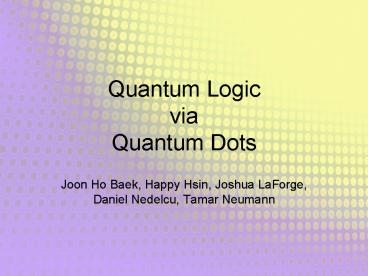Quantum Logic via Quantum Dots - PowerPoint PPT Presentation
1 / 21
Title:
Quantum Logic via Quantum Dots
Description:
What physical properties of a quantum dot can be used to ... University of New Castle: Condensed Matter Theory. http://cmt.phys.ncl.ac.uk/research/dot.php ... – PowerPoint PPT presentation
Number of Views:179
Avg rating:3.0/5.0
Title: Quantum Logic via Quantum Dots
1
Quantum Logic via Quantum Dots
- Joon Ho Baek, Happy Hsin, Joshua LaForge, Daniel
Nedelcu, Tamar Neumann
2
Project Questions
- What physical properties of a quantum dot can be
used to carry quantum information? - How do we create simple quantum gates using these
systems? - How do we create simple quantum circuits using
these systems?
3
Quantum Dots
- Semiconductor nanocrystal.
- Prepared using molecular-beam epitaxy or colloid
techniques. - Physical boundary of the Qdot confines excitons
in a 3D well. - Dimensions on the order of the exciton Bohr
radius (10nm).
University of New Castle Condensed Matter
Theory http//cmt.phys.ncl.ac.uk/research/dot.php
4
Quantum Dots
- The strong confinement in three dimensions
produces new phenomena not seen in the bulk
material. - Useful for quantum computation because of
environmental isolation, and the reduction of
internal degrees of freedom that could lead to
decoherence.
Strouse, G. University of California Santa
Barabara http//www.chem.ucsb.edu/strouse_group/r
esources.html
5
Electron Spin
- Pros
- Dephasing time 0.1 µs with gate switching
speeds of 30 ps - Spin coherent transport of 100µm
- Expect longer decoherence times than charge
degrees of freedom since spin is insensitive to
electrical potential - Scalable arrays
- Cons
- Cryogenic temperatures for long coherence times.
6
Proposed System
- All electrical system
- Qdots defined by electrical gating of 2DEG
- Allows for very fast switching times (ps)
- Scalable to arbitrary size
Golovach VN, Loss D. Semicond. Sci. Technol. 17
(2002) 355366
7
Quantum Gates
- Single-qubit operations translate to single spin
rotations - Need localized magnetic fields
- 2-qubit gates formed through coupled quantum dots
- Square root of the swap operator used to create
an XOR (cNOT) gate - XOR and single qubit operations are universal
8
Read-Out
- Tunnel in supercooled paramagnetic dot.
- Use spin-valve to selectively transfer spin to
another quantum dot, which can be measured using
an electrometer.
9
Spin Off
- Domino Dots
- 5 dots
- 4 electrons
- These states are not
- mutually orthogonal
- Orthogonal states
- Gates can be created by
- increasing tunneling
- The important part
- Any SU(2) rotation can be
- done with H12 and H14
- (note H12H34 and H14 H23)
agt
bgt
cgt
0gt agt
1gt (bgt cgt)/v2
H 12
H 14
10
Spin Off
- Domino Dots (take 2, part 2)
- 2-qubit gates
- Combine with single qubit rotation for an
arbitrary unitary transformation - Since these all exist in a singlet ground state,
they are virtually immune to most types of
decoherence
11
Taking Charge
- Domino Dots (take 2) Cellular Automata
- 5 dots
- 2 electrons
- Cascade effect
- (wireless interconnect)
- Majority rule
1gt
0gt
? More energetically favorable
Input cells
Device cells
Vheight of barrier controlled by top gate
Energy of e- coming from source
Mean energy from free e-
?
source
drain
Output cell
V potential at bottom of well controlled by
bottom gate
12
Taking Charge
- Logic Gates (examples)
- Inverter
- branch
- And/Or
- 1 fixed input
- 0 for or
- 1 for and
- 2 variable inputs
13
Quantum Computing with QD Excitons
- Excitons electron-hole pairs
- Pros
- Easy to initialize
- Scalable
- Easy read-out
- Cons
- decoherence times are relatively short
(20-100ps) - BUT it is possible to induce fast unitary
time-evolution by using a coherent ps or fs laser
radiation!!
H.Kamada, Quantum Computing with QD Excitons,
NTT Technical Review Online 1 3 (2003)
14
Single Qubit Rotation
Rabi oscillations
15
Rabi Oscillations
Pump power a T(inf) total pulse
area Excitation of the QD resonance can be
controlled by the strength of the pump pulse
T 6K, Rabi oscillations
16
CNOT implementation
Using a coherent laser (p-pulse with energy
EcDEct) will result in a p rotation if and only
if the control bit is in state 1cgt.
What about performing CNOTs on remote QDs?
17
Remote CNOT gate
SWAP
agt
bgt
bgt
agt
R1 R2
SWAP SWAP CNOT SWAP SWAP
R1 R2
R1 R2
C T
18
Read-out
Probe beam
Statistical distribution of QD size and
composition gives different QD optical responses
? Easy to differentiate btwn QDs BUT
current strategy requires a number of repeated
measurements
QD1 QD2 QD3
QD1
QD3
QD2
19
Comparison
20
Remarks
- We also looked at other areas, such as
decoherence of electron spin states due to
polaron formation, and nuclear spin that we did
not have time to discuss. - The methods that we discussed all deserve further
investigation.
21
References
- Stievater, T. H, et al. Rabi oscillations of
excitons in single quantum dots, PRL 87, 13,
(2001) - Kamada, H., Quantum computing with qd exitons,
NTT Technical Review, vol 1, no. 3, (2003) - Loss D, DiVincenzo D. Quantum computation with
quantum dots. Physical Review A 57 (1) (1998) - Hellberg, C., Robust quantum computation with
quantum dots, http//www.arxiv.org/quant-ph/030415
0 v1 (2003) - Golovach V, Loss D. Electron spins in artificial
atoms and molecules for quantum computing.
Semiconductor Science and Technology 17 (2002) - DiVincenzo D, Loss D. Quantum computers and
quantum coherence. Journal of magnetism and
magnetic materials. 200 (1999)

